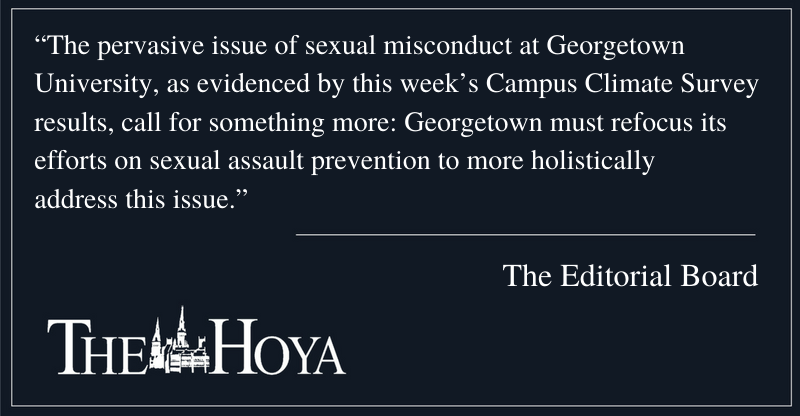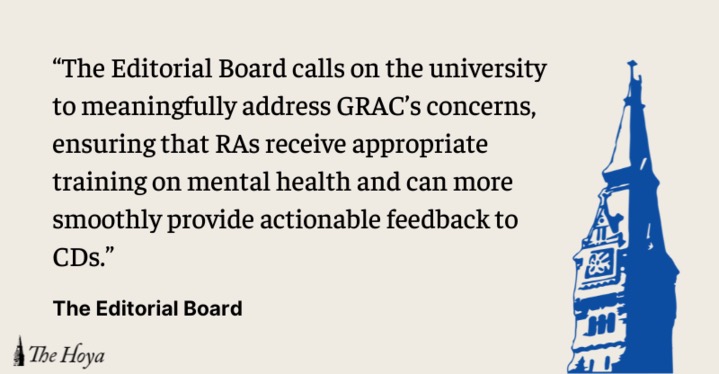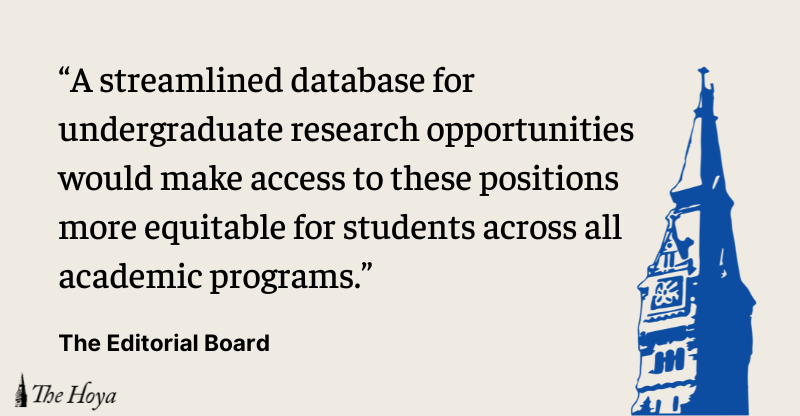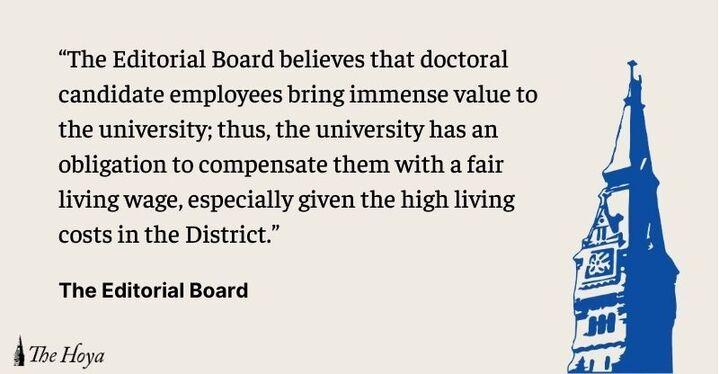As sexual misconduct remains a pervasive issue on Georgetown University’s campus, the university’s education programs surrounding this issue have also been woefully inadequate.
Moving forward, the university must address the issues with a culture of sexual misconduct on campus and devote more resources to sexual assault prevention training and current bystander training programs.
Georgetown has a problematic culture of sexual misconduct, most recently illuminated through high-profile cases in the past two years.
Last fall, Georgetown University Student Association President Sahil Nair (SFS ’19) resigned after accusations of sexual misconduct. Vice President Naba Rahman (SFS ’19), Chief of Staff Aaron Bennett (COL ’19) and nine other senior staff members were later pressured to resign after allegations that they knew of Nair’s misconduct. No complaints were filed against Nair through the Title IX office or the Office of Student Conduct, according to Nair and confirmed by a university spokesperson.
Less than two months ago, students reported that Hoya RealTalk, a play during New Student Orientation that discusses sexual misconduct, featured inappropriate messaging. Orientation Advisor Escadar Alemayehu (NHS ’22) detailed the problems with the play in an October op-ed, including a scene in which a sexual predator is forgiven by a group of his peers, including the woman he assaulted.
Additionally, the results of the 2019 Campus Climate Survey on Sexual Assault and Misconduct, released this week, show that prevalence of sexual assault has remained the same since the 2016 survey. 31.6% of undergraduate women, 11.6% of undergraduate men and 31.3% of gender nonconforming undergraduates have experienced assault since entering college. All three numbers are higher than the Association of American Universities average.
However, the 2019 survey is encouraging in showing that 78.4% of students took action when they witnessed “a situation they believed could lead to a sexual assault,” up from 22.9% in 2016. Georgetown attributes the increase to the mandatory bystander intervention training for all incoming first-year students instituted in 2017.
Though the university’s efforts for bystander training are important, the training is inadequate in comprehensively addressing sexual assault. Bystander intervention does not adequately address sexual assault prevention and consent, according to Maya Stevenson (COL ’20), who is a Resident Assistant in Harbin Hall.
“Students questioned why the University only discusses consent with incoming freshman via a mandatory online module (which they noted students exchange tips for skipping through without having to actually watch the videos) but devote a 5-hour in-person training to bystander intervention.” Stevenson wrote in a message to The Hoya. “Overall, residents shared that the training was important but felt incomplete.”
By focusing almost exclusively on bystander training, Georgetown does not holistically address the pervasive culture of sexual misconduct. Bystander training is insufficient, according to Sara Collina, a professor in the women’s and gender studies program.
“There is some evidence that bystander intervention programs can be effective in increasing people’s confidence to intervene, but this week’s distressing climate survey report makes one thing very clear: WHAT WE ARE DOING IS NOT WORKING,” Collina wrote in an email to The Hoya. “Trying harder with the same tools is not the answer.”
With the levels of sexual assault not changing over the past three years, Georgetown cannot become complacent in its education programs simply because of the improved bystander intervention rates. The university should explore more comprehensive solutions.
To address the fundamental flaws in its system, the university should rethink its sexual assault education programs and include students in reforming the programs, according to Collina.
“I would recommend that Georgetown start from scratch in terms of sexual assault and harassment prevention. Then re-start by bringing students into the decision-making process,” Collina wrote. “Ask students to visualize a campus where sexual respect is the norm, then work backward.”
The university should not pat itself on the back for implementing bystander training without being more proactive in sexual assault prevention. Georgetown should create new programs to ask students to consider the privilege and power dynamics that perpetuate a culture of sexual assault. Students should discuss the race, gender and socioeconomic inequalities that lead to disparate rates of sexual assault. Students should also examine how power dynamics can perpetuate sexual assault and ways in which such problems can be alleviated.
Bystander training is important, but it is woefully insufficient to address the larger cultural issues at Georgetown. The pervasive issue of sexual misconduct at Georgetown, as evidenced by this week’s survey results, call for something more: Georgetown must refocus its efforts on sexual assault prevention to more holistically address this issue.
The Hoya’s editorial board is composed of six students and chaired by the opinion editor. Editorials reflect only the beliefs of a majority of the board and are not representative of The Hoya or any individual member of the board.














